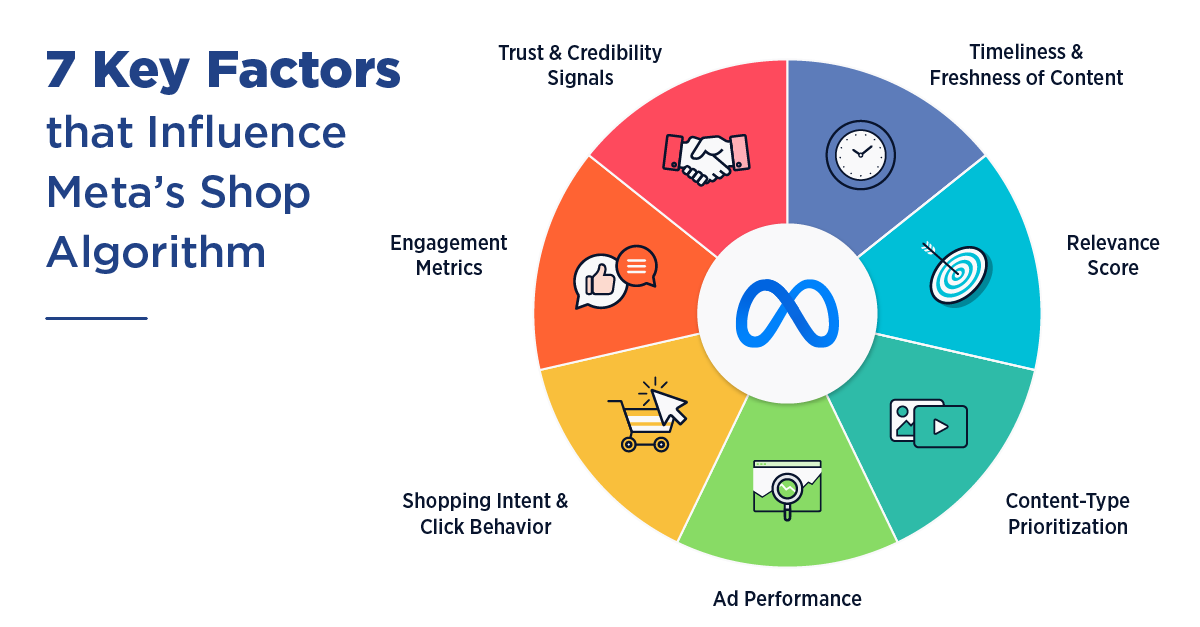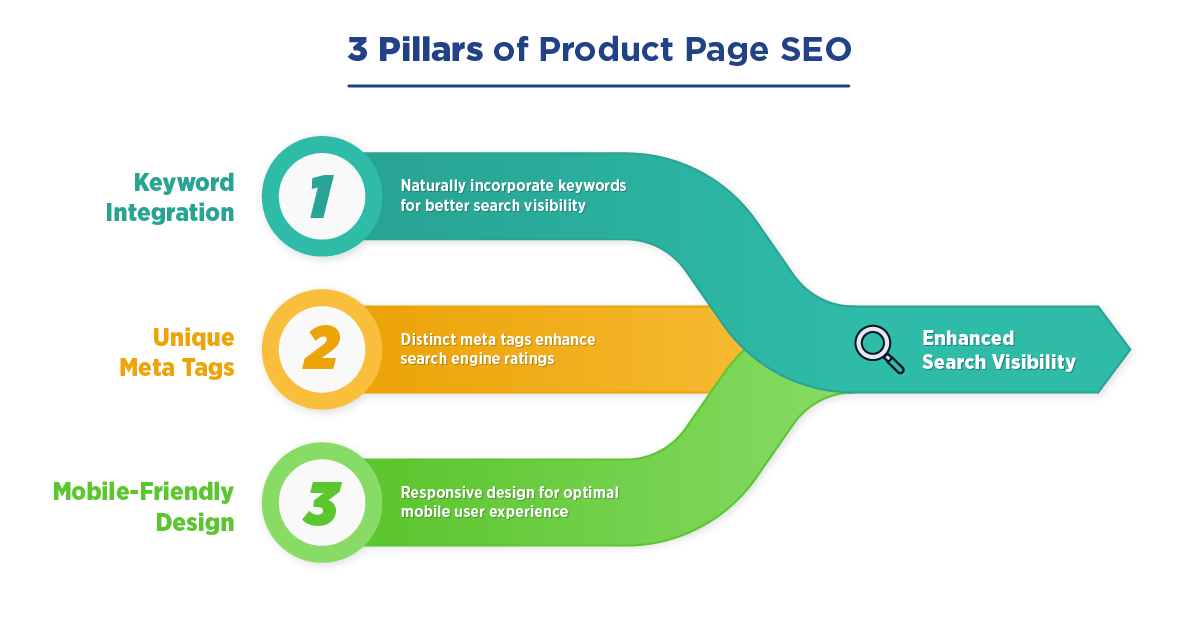Social media platforms have transformed how we shop online, with Meta (Facebook & Instagram) leading the charge. To boost e-commerce revenue on Meta's social shopping platforms, it's essential to understand their social search algorithms, recognize user shopping behaviors, and apply best practices to optimize product pages, images, and posts.
Understanding Meta's Social Search Algorithms
Meta's platforms, Facebook and Instagram, use advanced algorithms to deliver personalized content to users. These algorithms analyze various factors to determine what appears in a user's feed, search results, and recommendations. The goal is to ensure that users see content that resonates with their interests, increasing engagement and the likelihood of discovering and purchasing relevant products.
The 7 Factors of Meta’s E-commerce Algorithm
Here are the key factors that influence Meta’s e-commerce algorithm:

- Engagement Metrics (User Interaction Signals)– Meta prioritizes content that users actively engage with. The more engagement a post receives, the more likely it is to be shown to a wider audience. The algorithm considers:
- Likes and reactions – Posts with high engagement signals (likes, loves, wows) get boosted.
- Comments and replies – Conversations in the comments section signal strong interest in a post.
- Shares and saves – Content that users share with friends or save for later ranks higher.
- Relevance Score (Personalization & Interest Matching) – Meta assigns a Relevance Score to every piece of content based on a user’s past behavior. The algorithm analyzes:
- Previous interactions – If a user frequently engages with fashion content, they are more likely to see fashion-related posts and ads.
- Search history – Users who search for specific products (e.g., “running shoes”) will see related shopping posts and recommendations.
- Profile data – Location, demographics, and interests influence content recommendations.
- Content-Type Prioritization – Different types of content perform differently based on user preferences. Meta ranks:
- Video content higher – Reels, Stories, and live videos get more organic reach than static images.
- Interactive content (polls, quizzes, Q&A) – These formats boost engagement and keep users on the platform longer.
- Carousel posts & multi-image content – Encourages scrolling and interaction, increasing visibility.
- Shopping Intent & Click Behavior – Meta tracks how users interact with shopping-related content to refine product recommendations. The algorithm considers:
- Product clicks – If a user clicks on a product tag in an Instagram post, they will see more similar products.
- Checkout actions – Adding a product to the cart or completing a purchase improves visibility for related items.
- Engagement with shopping posts – Liking or commenting on shoppable posts increases exposure to similar items.
- Ad Performance & Paid Boosting – Paid content is a major part of Meta’s e-commerce strategy. The algorithm factors in:
- Ad engagement – Ads with high interaction (click-through rates, saves, shares) get prioritized in future placements.
- Ad spend and bidding strategy – Higher budgets and competitive bidding increase reach and visibility.
- Audience targeting precision – Businesses that use detailed audience targeting (age, gender, behavior, interests) see better performance.
- Timeliness & Freshness of Content – Meta prioritizes recent and trending content over older posts. Key factors include:
- Recency – New posts receive higher initial visibility, especially in Instagram’s Explore tab.
- Trend participation – Posts using trending hashtags, audio, or challenges get a boost.
- Seasonal content – Holiday promotions and seasonal product launches perform better during relevant timeframes.
- Trust & Credibility Signals – Meta rewards content from verified, reputable sources to prevent spam and misinformation. It evaluates:
- Business verification status – Verified pages and Instagram Shops receive higher priority.
- Customer reviews & ratings – Positive feedback improves a brand’s visibility.
- Consistency in posting – Brands that post regularly (3–5 times per week) see higher organic reach.
Why This Matters for E-Commerce
Understanding Meta’s ranking factors helps businesses optimize their content for better visibility. By focusing on engagement, relevance, shopping behavior, and credibility, brands can increase their organic reach, drive more traffic to their product pages, and improve conversions on Meta’s social shopping platforms.
Social Media Shopping Behaviors on Meta
Social media has transformed the way people shop, with Meta at the forefront of social commerce. Shopping on these platforms is no longer just about discovering products—it's a highly interactive experience that combines social proof, influencer recommendations, and personalized content.
How People Shop on Meta Platforms
54% of social media users use platforms like Facebook and Instagram to research products
Users don’t just browse—they actively seek out products, engage with brands, and rely on community input before making a purchase. According to a study by Search Engine Watch, 54% of social media users use platforms like Facebook and Instagram to research products, while 71% are more likely to buy products based on social media recommendations.
Here’s how people typically engage in shopping on Meta platforms:
Product Discovery Through Social Search & Feeds
The average user spends around 2.5 hours daily on social media, and during that time, they are exposed to thousands of pieces of content. Meta's algorithm prioritizes content that aligns with users’ interests, making it easy for people to discover new products. Whether through the Explore tab on Instagram, suggested content on Facebook, or keyword searches in the Marketplace, shoppers are constantly encountering new brands and products.
Influencer & Peer Recommendations
Social proof is a significant driver of purchase decisions. When people see their favorite influencers or friends using a product, they trust it more. A report from Porch Group Media found that 87% of shoppers believe social media helps them make informed buying decisions. Influencers—especially micro-influencers with highly engaged audiences—play a crucial role in this process by providing authentic product reviews and recommendations.
Engagement-Driven Shopping
Unlike traditional e-commerce, where people go to a website with a specific intent to purchase, social shopping is more impulsive and engagement-driven. Features like Instagram Shopping, Facebook Shops, and WhatsApp Business allow users to purchase products directly from a post or chat. In 2023, over 130 million Instagram users tapped on shopping posts each month to learn more about a product, showing how essential these integrations are for social commerce success.
Live Shopping & Interactive Shopping Experiences
Meta has invested heavily in live shopping, allowing brands to showcase products in real time while engaging with their audience. Live shopping streams, where brands or influencers demonstrate and discuss products, create an urgency similar to QVC-style shopping but with modern social media interactivity. According to Meta, live shopping events can increase purchase intent by up to 20%.
Mobile-First Shopping Experience
Since over 98% of Facebook and Instagram users access these platforms via mobile devices, social shopping is inherently mobile-driven. Brands that optimize their product listings for a seamless mobile experience, including easy-to-read text, clear call-to-action buttons, and fast-loading images, tend to see higher conversion rates.
Why These Behaviors Matter for Businesses
Understanding how people shop on Meta helps businesses tailor their content and advertising strategies. Shoppers are not just scrolling mindlessly—they are looking for inspiration, validation, and convenience. Brands that leverage interactive content, influencer partnerships, and seamless checkout options can significantly increase their e-commerce revenue on Meta’s platforms.
Best Practices for Optimizing Product Pages, Images, and Posts
To capitalize on these behaviors and Meta's algorithms, consider the following strategies:

-
Optimize Product Pages for Search Engines (SEO):
- Keyword Integration: Incorporate relevant keywords naturally into product titles and descriptions to improve search visibility.
- Unique Meta Tags: Create distinct meta titles and descriptions for each product page to enhance search engine rankings.
- Mobile-Friendly Design: Develop a mobile-first experience, as a significant portion of users access content via mobile devices.
-
Enhance Product Images
- High-Quality Visuals: Use clear, high-resolution images to showcase products effectively.
- Multiple Views: Provide various angles and close-ups to give customers a comprehensive understanding of the product.
- Alt Text Descriptions: Include descriptive alt text for images to improve accessibility and SEO.
-
Create Engaging Social Media Posts
- Consistent Branding: Maintain a uniform brand voice and aesthetic across all posts to build brand recognition.
- User-Generated Content: Share content created by customers, such as reviews or photos, to build trust and authenticity.
- Interactive Elements: Use polls, quizzes, and interactive stories to engage your audience and encourage participation.
-
Leverage Influencer Partnerships
- Micro-Influencers: Collaborate with influencers who have a dedicated and engaged following to promote products authentically.
-
Utilize Meta's Advertising Tools
- Shoppable Posts: Enable shopping features on Instagram and Facebook to allow users to purchase products directly from posts.
- Targeted Ads: Use Meta's advertising platform to create ads that reach specific demographics based on user data.
-
Encourage Customer Reviews and Ratings
- Social proof is displaying customer reviews and ratings prominently on product pages to build trust and influence purchasing decisions.
-
Monitor Analytics and Adjust Strategies
- Performance tracking includes regularly analyze engagement metrics to understand what content resonates with your audience and adjust your strategy accordingly.
Make More Money through Meta’s Shops
Optimizing content on Facebook and Instagram can help businesses attract relevant customers and make more sales. Contact our algorithm experts at High10.

